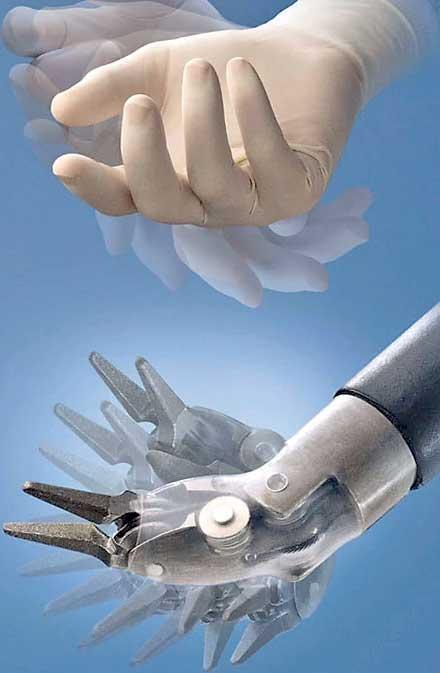04 Apr 2024 - {{hitsCtrl.values.hits}}

The robotic arm mimics human wrist movements
 At present, technology plays a main role in the field of medicine and health care. AI-automated machines have been constructed to ease the workload of doctors and to prevent severe mistakes from being made connected to the patient. A senior Consultant Urologist, and specialist in cancer, Incontinence, and robotic surgery, Dr.Chin Chong Min discusses the advancement of robotic technology and Prostate cancer. It is a type of cancer that forms in tissues of the prostate (a gland in the male reproductive system found below the bladder and in front of the rectum). “Prostate cancer is the number one cancer that is in Singapore. High-fat diets, like beef and meals with high animal fat and saturated fat, cause Prostate cancer. Incontinence happens when the bladder malfunctions during pregnancy in women. When you operate on a patient, especially with Prostate cancer and remove a prostate, the operation often destroys the structure which causes incontinence,”said Dr.Chin.
At present, technology plays a main role in the field of medicine and health care. AI-automated machines have been constructed to ease the workload of doctors and to prevent severe mistakes from being made connected to the patient. A senior Consultant Urologist, and specialist in cancer, Incontinence, and robotic surgery, Dr.Chin Chong Min discusses the advancement of robotic technology and Prostate cancer. It is a type of cancer that forms in tissues of the prostate (a gland in the male reproductive system found below the bladder and in front of the rectum). “Prostate cancer is the number one cancer that is in Singapore. High-fat diets, like beef and meals with high animal fat and saturated fat, cause Prostate cancer. Incontinence happens when the bladder malfunctions during pregnancy in women. When you operate on a patient, especially with Prostate cancer and remove a prostate, the operation often destroys the structure which causes incontinence,”said Dr.Chin.
He said that men above 65 are often subjected to prostate cancer. It even can cause death if it isn’t detected early. Prostate cancer generally doesn’t cause symptoms in its early stages,  but symptoms like difficulty in passing urine, slow urinary stream with dribbling towards the end, frequent urination, blood in the semen, bone pain and limb weakness can be detected. It’s important to note that these symptoms are mostly caused by Benign Prostate Enlargement (BPH) or prostate infection. Prostate cancer develops with risks such as geography (more common in Western countries), race (more common in black men) and family history (risk is doubled if you have a brother or father who has had prostate cancer). 9% of prostate cancer is genetic. Though individuals maintain a healthy lifestyle, 9% are sure to develop prostate cancer.
but symptoms like difficulty in passing urine, slow urinary stream with dribbling towards the end, frequent urination, blood in the semen, bone pain and limb weakness can be detected. It’s important to note that these symptoms are mostly caused by Benign Prostate Enlargement (BPH) or prostate infection. Prostate cancer develops with risks such as geography (more common in Western countries), race (more common in black men) and family history (risk is doubled if you have a brother or father who has had prostate cancer). 9% of prostate cancer is genetic. Though individuals maintain a healthy lifestyle, 9% are sure to develop prostate cancer.
“Prostate cancer is often diagnosed by a blood test called Prostate Specific Antigen (PSA) and it is the most common way of detecting prostate cancer. Cancer is suspected when the PSA is > 4 ug/L although large benign prostates and prostatitis (infection) can also cause a similar rise. 95% of prostate cancers are curable if it is in stage 1 or 2 because it is inside the prostate,” explained Dr.Chin. “But stage 2 signifies a higher volume cancer. Symptoms of this cancer are shown during stage 3 and 4. There are excess types of proteins in the blood level that can be picked up in the blood to identify this cancer. Prostate cancer was the second most common cancer among males all over the world in 2020. As per the global cancer observatory 1, 414, 259 (7.3%) cases of prostate cancer were diagnosed in 2020 worldwide. In Sri Lanka, prostate cancer is the fifth most common cancer among men. Prostate cancer is rare in men who are younger than 40, but the chance of developing prostate cancer rises rapidly after age 50.
Robotic surgery is the use of robotic technology to perform complex surgeries. Robotic surgery is useful in the fields of urology, Prostate Cancer, Kidney Cancer, Kidney pelvis obstruction, Ureter structure and Bladder cancer because these surgeries are reconstructive and require precise, water-tight suturing. “Technology enables us to do the same surgery safer with less bleeding and better outcomes. When the stitching process gets complicated there are smaller robots that are used to stitch in the tiny places. These robots help to magnify the image fivefold during surgery. During Laparoscopic Surgery vision in the monitor is magnified thrice. Therefore, the use of robots during surgery is increasing worldwide,”said Dr.Chin.
Recovery speed is high
 According to Dr.Chin, the recovery speed is high and the pain will be less. The pain,during surgery when a robot is used, will last for 2 days, but the pain after an open surgery will last for more than 2 weeks. There are only 0.04% malfunctions reported during these types of surgeries. Dr.Chin explained that these robots are designed to be inserted adopting safety measures and their optimum performance should be maintained to avoid malfunctions. Opting for robotic surgery is a one-time cost. He explained that the da Vinci Surgical System is a robotic surgical system that uses a minimally invasive surgical approach. But now there are other robots introduced in the market, so their cost goes down. Robotic surgery has shown to improve patient recovery because of less pain, less blood loss, less fear, less damage to surrounding structures and fewer complications. “Patients who benefit from robotic surgery will always opt for a similar surgery because it is not uncomfortable,” said Dr.Chin.
According to Dr.Chin, the recovery speed is high and the pain will be less. The pain,during surgery when a robot is used, will last for 2 days, but the pain after an open surgery will last for more than 2 weeks. There are only 0.04% malfunctions reported during these types of surgeries. Dr.Chin explained that these robots are designed to be inserted adopting safety measures and their optimum performance should be maintained to avoid malfunctions. Opting for robotic surgery is a one-time cost. He explained that the da Vinci Surgical System is a robotic surgical system that uses a minimally invasive surgical approach. But now there are other robots introduced in the market, so their cost goes down. Robotic surgery has shown to improve patient recovery because of less pain, less blood loss, less fear, less damage to surrounding structures and fewer complications. “Patients who benefit from robotic surgery will always opt for a similar surgery because it is not uncomfortable,” said Dr.Chin.
30 Apr 2024 3 hours ago
30 Apr 2024 3 hours ago
30 Apr 2024 4 hours ago
30 Apr 2024 4 hours ago
30 Apr 2024 5 hours ago